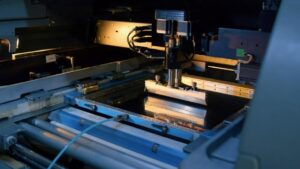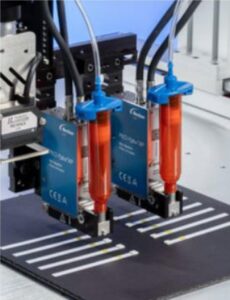In the world of printed electronics and conductive inks, applications drive choices. From medical wearables to flexible displays to NFC devices and automotive parts, each use case demands specific performance characteristics. At NovaCentrix, we understand that no single ink formulation fits every need. With one of the industry’s largest portfolios of conductive and functional inks, we are uniquely positioned to provide solutions that deliver optimal performance, throughput, and cost-efficiency.
At NovaCentrix, we go beyond providing conductive inks. We ensure that our materials align with the printing processes and performance goals of our customers. By optimizing performance, throughput, and cost, we enable our partners to achieve success in diverse industries.
Matching Conductive Ink to Applications
Selecting the right ink begins with understanding the specific requirements of the end application. Factors like conductivity, curing temperature, print thickness, adhesion, and substrate compatibility all influence the deposition method and in turn the choice of ink. Here is a quick overview of printing processes and how they may be different for different applications.
- Screen Printing and Dispensing with Conductive Ink: Perfect for thick prints (>5 microns) that require low resistance and excellent adhesion, such as in automotive electronics or thermoformed devices. Our inks for these methods are available in both water- and solvent-based formulations, ensuring compatibility with a wide range of processes.


- Inkjet Printing with Conductive Ink: Offering unparalleled precision and the ability to make on-the-fly design changes, inkjet printing is suited for prototyping and small-batch production, but with a very clear path to production scale deployment. With dry print thicknesses of 0.5-3 microns and compatibility with roll-to-roll processing, this method balances performance and flexibility.

- Flexographic and Aerosol Printing with Conductive Ink: Ideal for high-speed production and high-resolution designs, flexographic printing enables fine lines as narrow as 10 microns to be printed. Flexographic printing excels in applications like RFID antennas and printed circuits, where thin prints (<2 microns) and low curing temperatures (as low as 80°C) are crucial. With similar advantages in terms of resolution (but not throughput) but adding the ability for non-contact printing along curved and 3d surfaces, aerosol printing is gaining strong popularity in the area of flexible hybrid electronics.

A Conductive Ink Portfolio That Leads the Industry
NovaCentrix’s portfolio of conductive and functional inks includes formulations with a wide variety of materials such as gold, silver, silvercoated copper, platinum, copper and carbon. For certain specific applications even other materials can be considered in consultation with the customer. This large materials library allows us to design inks that deliver:
- Wide range of conductivity for various applications.
- Low curing temperatures, enabling use on temperature-sensitive substrates.
- Compatibility with diverse substrates, including flexible and 3D surfaces.
Customization: The NovaCentrix Advantage
While our extensive portfolio meets the needs of many applications, we recognize that some challenges require tailored solutions. That’s why NovaCentrix offers customization services, working closely with end users to develop ink formulations that address specific technical and operational requirements.
Whether it’s creating an ink for a new material, optimizing for a unique substrate, or balancing throughput and cost, our team of experts collaborates with customers to deliver solutions that exceed expectations. This commitment to customization ensures that our inks not only perform but also integrate seamlessly into existing manufacturing processes.
Applications drive choices, and at NovaCentrix, we pride ourselves on delivering the right solutions for every need. With our broad portfolio of conductive and functional inks, coupled with our ability to customize formulations for specific applications, we empower innovators to push the boundaries of what’s possible. Let’s work together to create the future of electronics, one ink at a time.
For more information about our portfolio and customization services, visit NovaCentrix’s website.
Related Post: It’s PRINTED electronics – so let’s talk printing!


